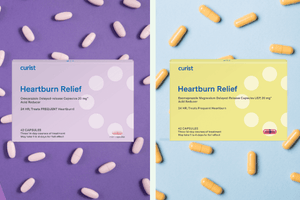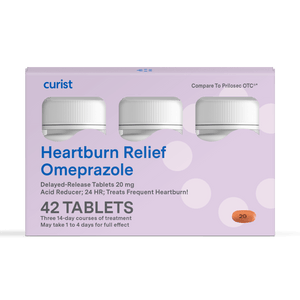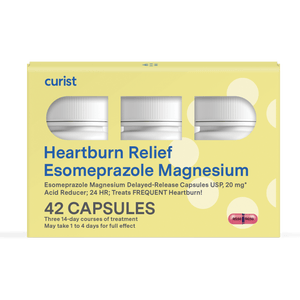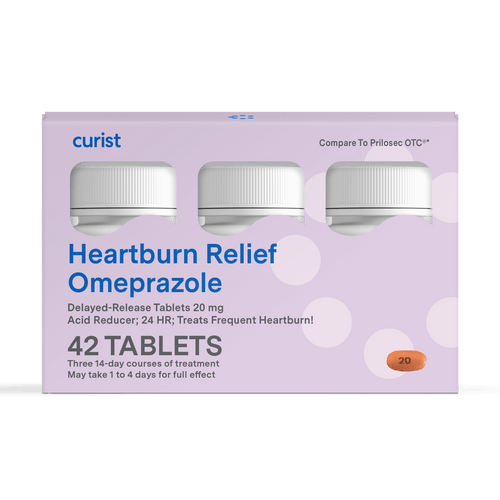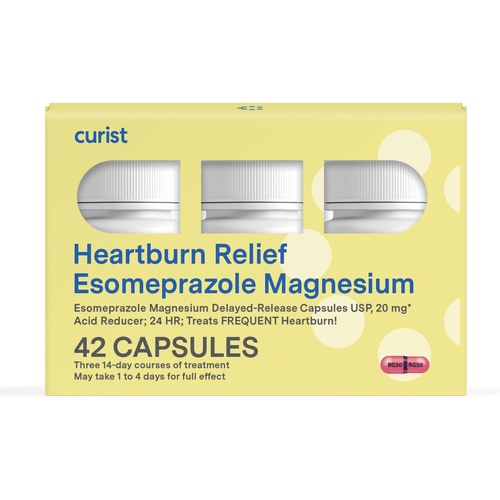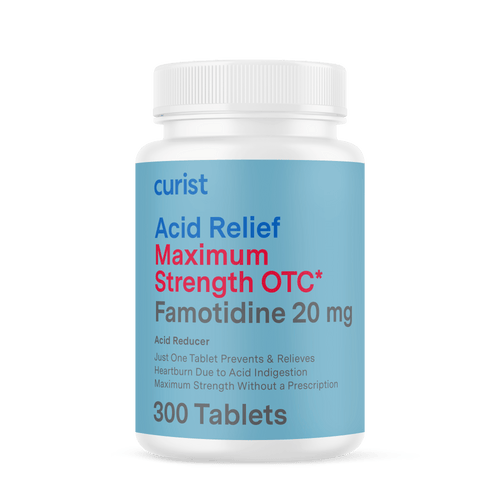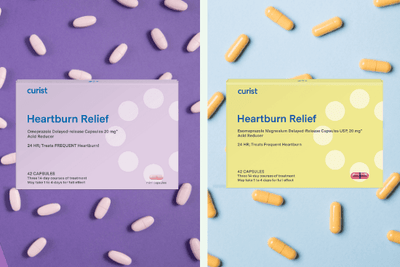By Deni Hui, The University of Texas at Austin College of Pharmacy
Curist delivers over-the-counter medicines to your door at a fraction of the price of traditional brands. We hope everyone stays safe and healthy during this time.
To treat symptoms of heartburn and acid reflux, there are a variety of over-the-counter (OTC) and prescription options available. These products generally fall into one of three categories: antacids, histamine 2 blockers (H2 blocker) and proton pump inhibitors (PPIs). In this article, we will be comparing H2 blockers to PPIs and see how they work differently in managing your heartburn.
What is Heartburn or Acid Reflux?
Heartburn is an uncomfortable, burning sensation or pain located in your lower chest, just behind your breastbone. This pain can often get worse after eating (within an hour after meals), in the evening or when lying down at night.
Heartburn is a symptom of acid reflux. Acid reflux is a medical condition in which stomach acid flows backward into your esophagus, the tube that connects your mouth to your stomach. Acid reflux can sometimes progress to GERD which is the chronic form of acid reflux and is more severe. Again, heartburn is a feeling of burning in the chest, so it is a symptom of both acid reflux and GERD.
Because people experience heartburn differently, they treat it differently too. Some take medications for heartburn relief, while others may manage the discomfort of heartburn on their own through lifestyle changes and without medications.
If you would like a better understanding of how heartburn is caused and how you can properly treat it, make sure to check out our common heartburn myths vs facts article!
H2 blockers: What are Pepcid, Zantac and Tagamet?
Pepcid (famotidine), Zantac (ranitidine), and Tagamet (cimetidine) are histamine-2 receptor blockers. They are intended to treat mild and infrequent heartburn by reducing the amount of acid our stomach produces. In addition to treating heartburn, Pepcid and Tagamet can also be used to prevent heartburn (especially when one can anticipate an event of heartburn) and ulcers in the stomach and intestines.
Currently, the original form of Zantac with the active ingredient ranitidine is no longer available in the market. The FDA has recalled all other ranitidine products because of contamination with NDMA, a chemical that may cause cancer. Recently, Zantac re-launched with the active ingredient famotidine, which is the same as in Pepcid.
PPI: What is Protonix (Pantoprazole)?
Protonix (pantoprazole) belongs to a class of medications called proton pump inhibitors (PPIs) and works similarly to Nexium (esomeprazole) and Prilosec (omeprazole). PPIs all work by shutting down “pumps” that release acid into your stomach. However, unlike Nexium or Prilosec, Protonix is a prescription-only medication used to specifically treat symptoms of esophagitis caused by stomach acid due to gastroesophageal disease or GERD. Protonix helps heal the acid damage to the stomach and esophagus, prevent ulcers and may prevent esophageal cancer.
And unlike H2 blockers, PPIs take time to work and thus, are not designed to treat infrequent heartburn or be an immediate relief for acid reflux symptoms.
Are Pepcid, Tagamet and Protonix the Same Thing?
No. Pepcid, Tagamet and Protonix are not the same thing. While they all can help treat acid reflux, they work differently and therefore have different use cases. Pepcid/Tagamet and Protonix belong to two different drug classes. Pepcid and Tagamet are H2 blockers while Protonix is a PPI. Even though they both decrease your production of stomach acid, they work in different ways in your body. Both classes can be used to treat and prevent recurrence of stomach and duodenal ulcers. Pepcid and Tagamet are mainly useful in relieving mild, infrequent heartburn which occurs less than 2 episodes per week, while Protonix is useful in managing frequent heartburn (i.e. GERD) that occurs 2 or more days a week.
What is the Difference: Pepcid vs Tagamet vs Protonix?
Pepcid, Tagamet and Protonix are all considered effective medications for the treatment of heartburn and acid reflux, however, they differ in how they work and how they are used.
Pepcid vs Tagamet vs Protonix: Frequency of Heartburn
As H2 blockers, Pepcid (famotidine) and Tagamet (cimetidine) are intended to treat mild, infrequent heartburn which occurs less than 2 episodes per week. They can also treat GERD and certain types of ulcers in the stomach and intestines. Most importantly, this class of medications can be used to prevent heartburn, especially when one can anticipate an event of heartburn. They can be taken 30 minutes to 1 hour before a meal to prevent an acid reflux episode.
On the other hand, PPIs, like Protonix (pantoprazole), are only intended to treat frequent heartburn which occurs 2 or more days a week. They are not meant for immediate relief.
Pepcid vs Tagamet vs Protonix: Onset of Action
H2 blockers like Pepcid (famotidine) and Tagamet (cimetidine) typically start relieving heartburn symptoms in just 15 to 30 minutes and can control acid for up to 12 hours. They can be taken up to twice daily as needed for 14 days. If you feel the need to use it for more than 14 days, make sure to consult a healthcare professional first because long-term use of H2 blocker can suggest ineffective therapy.
Protonix (pantoprazole), on the other hand, is prescription-only and should be taken as directed (typically 1 hour before meal). Some people can get complete symptom relief within 2 to 3 days, but for others, it can take up to 4 weeks for full effect.
Pepcid vs Tagamet vs Protonix: Side Effects
Pepcid, Tagamet and Protonix are all considered well tolerated medications. Most people do not experience side effects from taking them, but it is possible to experience constipation, diarrhea, nausea, dizziness or headaches in some cases.
However, more serious side effects (e.g. confusion, hallucinations or delirium) from H2 blockers can sometimes occur in people who have kidney or liver issues and those over 50 years old. These side effects are most common with Tagamet (cimetidine), though they can happen with other H2 blockers as well. We recommend you to check with your healthcare provider first if you have any kidney or liver problems before starting an H2 blocker.
Which Works Better for Heartburn: Pepcid, Tagamet or Protonix?
Both PPIs (Protonix) and H2 blockers (Pepcid, Tagamet) work by blocking and reducing the amount of stomach acid our body produces. However, randomized controlled trials have shown that PPIs (Protonix) is more effective in treating GERD than H2 blockers. PPIs, like Protonix, are considered stronger and faster in decreasing stomach acid production compared to H2 blockers.
When comparing the individual H2 blockers, unfortunately, since there are not many large clinical trials, it is hard to say that one H2 blocker works better than the other in treating heartburn or acid reflux symptoms. However, your healthcare provider may recommend one over the other for various reasons. For example, Tagamet (cimetidine) has a lot of drug interactions. It interacts with medications such as warfarin, aspirin, and some antidepressants. If you are unsure whether your medication interacts with cimetidine, reach out to your healthcare provider first as they may recommend a different H2 blocker for relieving your heartburn symptoms.
Lastly, H2 blockers were also found to significantly reduce the stomach acid released in the evening which is a common contributor to peptic ulcers. This is the reason why H2 blockers are typically used to treat people who have ulcers or who are at risk for getting them; while PPIs are more often prescribed for people with GERD or frequent heartburn episodes.
Can I take Protonix with Pepcid or Tagamet Together?
No. Protonix and Pepcid (or Tagamet) should not be taken together. Scientists and clinicians do not recommend taking both a PPI and an H2 blocker at the same time as they have overlapping mechanisms of actions despite working at different stages of production. When used together, it could ultimately lead to extensive acid suppression and decrease the absorption of key nutrients such as Vitamin B12, iron, and calcium. These nutrients are dependent on an acidic environment to be effectively absorbed into our body. This combination therapy of Protonix and Pepcid (or Tagamet) may also increase the risk of hip fractures and gastrointestinal infections.

